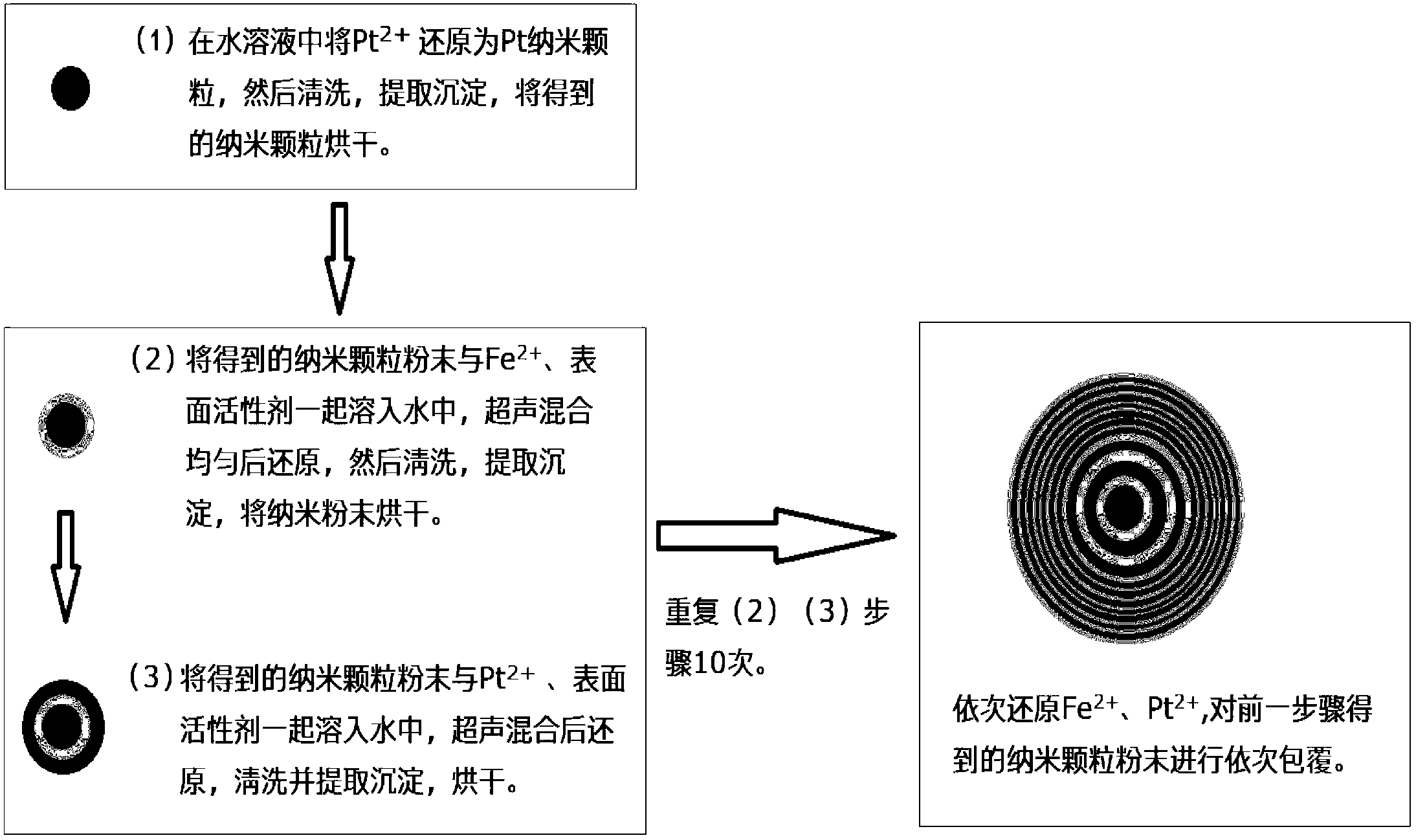Chemical method for synthesizing L10-FePt by sequentially coating nanopowder nuclear body
A l10-fept, nano-powder technology, applied in nanotechnology and other directions, can solve problems such as inappropriate use and difficult process operation, and achieve the effect of commercialization
- Summary
- Abstract
- Description
- Claims
- Application Information
AI Technical Summary
Problems solved by technology
Method used
Image
Examples
preparation example 1
[0014] 1. Prepare the solution: prepare the sample: mix H 2 PtCl 6 ·6H 2 O(n Pt mol) is soluble in water, the volume of water (liter) is related to n pt (mole) ratio is 25:1, dubbed into aqueous solution; FeCl 2 4H 2 O(n Fe mol) is soluble in water, the volume of water (liter) is related to n Fe (mole) ratio is 25:1, made into an aqueous solution, weighed CTAB n Fe +n Pt mol.
[0015] 2. Experimental steps
[0016] ① put n Fe +n Pt Put moles of CTAB into a three-necked flask to form an aqueous solution. The ratio of the volume of water (liter) to the molar amount of CTAB is 25:1. Heat to 70°C in a collector-type constant temperature heating magnetic stirrer, and continuously pass in argon protective gas for stirring.
[0017] ② Add hydrazine hydrate with a test tube Fe +n Pt Mole, followed by the dropper to H 2 PtCl 6 ·6H 2 One-tenth of the O solution was dropped into a three-necked flask, and stirred for 2 hours for reaction reduction.
[0018] ③ After the...
preparation example 2
[0024] 1. Prepare solution with example one.
[0025] 2. Experimental steps
[0026] ① Put CTAB(n Fe +n Pt mol) into a three-necked flask to form an aqueous solution, the ratio of the volume of water (liter) to the molar amount of CTAB is 25:1. Heat to 70°C in a collector-type constant temperature heating magnetic stirrer, and continuously pass in argon protective gas for stirring.
[0027] ② Add hydrazine hydrate with a test tube Fe +n Pt mol, followed by a dropper to FeCl 2 4H 2 One-tenth of the O solution was dropped into a three-necked flask, and stirred for 2 hours for reaction reduction.
[0028] ③ After the reaction is over, stop stirring, stop feeding argon, and add excess alcohol until the foam disappears. The reaction product was transferred to a beaker, filled with deionized water, and allowed to stand. After the black powder is completely settled, a permanent magnet is placed at the bottom of the beaker, and the supernatant is poured out. After repeating ...
preparation example 3
[0033] 1. Prepare solution with example one.
[0034] 2. Experimental steps
[0035] ① Put CTAB(n Fe +n Pt ) into a three-necked flask to make an aqueous solution, the ratio of the volume of water (liter) to the molar amount of CTAB is 25:1. Heat to 70°C in a collector-type constant temperature heating magnetic stirrer, and continuously pass in argon protective gas for stirring.
[0036]
x1
x2
x3
x4
x5
x6
x7
x8
x9
x10
Fe 2+
0.025V
0.042V
0.058V
0.072V
0.092V
0.108V
0.125V
0.142V
0.158V
0.175V
Pt 2+
0.025V
0.042V
0.058V
0.072V
0.092V
0.108V
0.125V
0.142V
0158V
0.175V
[0037] ② Add n with a test tube Fe +n Pt moles of hydrazine hydrate, followed by pipetting x1ml of H 2 PtCl 6 ·6H 2 O solution was dropped into a three-necked flask, and stirred for 2 hours for ...
PUM
 Login to View More
Login to View More Abstract
Description
Claims
Application Information
 Login to View More
Login to View More - R&D
- Intellectual Property
- Life Sciences
- Materials
- Tech Scout
- Unparalleled Data Quality
- Higher Quality Content
- 60% Fewer Hallucinations
Browse by: Latest US Patents, China's latest patents, Technical Efficacy Thesaurus, Application Domain, Technology Topic, Popular Technical Reports.
© 2025 PatSnap. All rights reserved.Legal|Privacy policy|Modern Slavery Act Transparency Statement|Sitemap|About US| Contact US: help@patsnap.com

